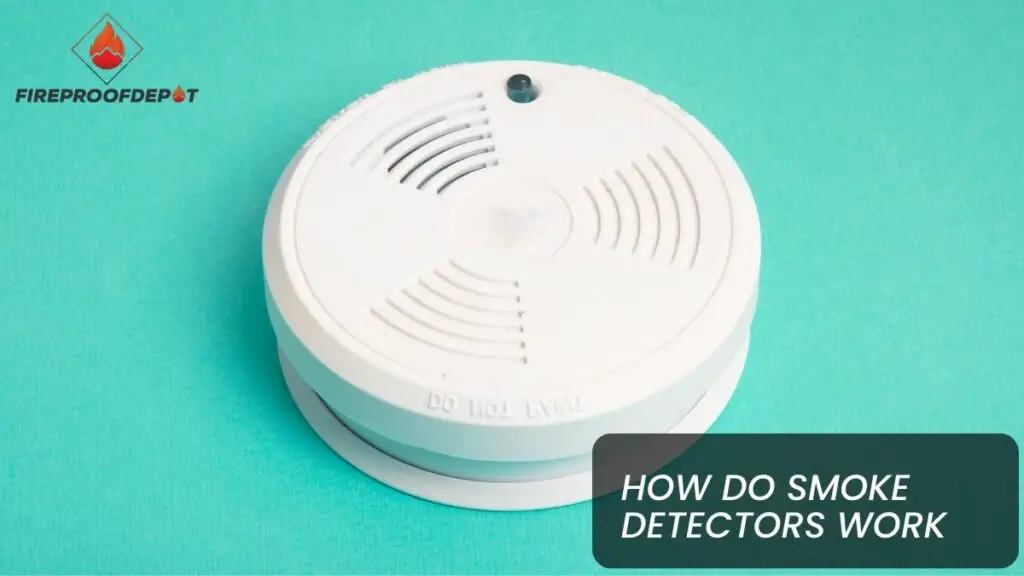Your smoke detector tirelessly watches over your home and office day and night, ready to leap into action at the first sign of danger.
But have you ever think how do smoke detectors work? How do they detect the faintest hint of smoke and react in a split second?
To detect smoke vapors in the air, smoke detectors use either ionization, photoelectric sensors, air sampling etc. In ionization detectors, a radioactive source creates ionized air, while in photoelectric detectors, a light beam detects scattered smoke particles. When smoke is detected, the alarm is triggered, alerting occupants of potential fire hazards.
Let me help you understand the process in a simpler way.

How Do Different Types Of Smoke Detectors Work?
There are various types of different smoke detectors. Each type employs different technologies to detect smoke particles in the air.
Ionization Smoke Detectors
Radioactive Material: Ionization smoke detectors contain a small amount of radioactive materialAmericium-241. The radioactive material emits alpha particles.
Ionization Chamber: The detector comprises an ionization chamber, which is essentially two plates with a voltage applied across them, creating a small electrical current.
Smoke Detection: When smoke enters the ionization chamber, it disrupts the flow of ions and electrons, reducing the electrical current.
Alarm Activation: The drop in current triggers the smoke detector’s alarm, signaling the presence of smoke or a potential fire.
Photoelectric Smoke Detectors
Light Source and Photocell: Photoelectric smoke detectors use a light source, often an LED, and a photocell (light sensor).
Light Beam: The light source emits a beam of light directed away from the photocell and into a receiving chamber.
Smoke Detection: The light beam is scattered by the smoke particles as it enters the chamber, causing some of the light to reach the photocell.
Alarm Activation: The reduction in light intensity reaching the photocell triggers the smoke detector’s alarm.
Related Guide: Photoelectric vs Ionization Smoke Detectors
Dual-Sensor Smoke Detectors
Combined Technologies: Dual-sensor smoke detectors combine both ionization and photoelectric technologies in a single unit.
Enhanced Detection: By having both technologies, these detectors can quickly detect both fast-flaming fires (ionization’s strength) and slow, smoldering fires (photoelectric’s strength).
Alarm Activation: If either technology detects smoke, the alarm is triggered, providing more comprehensive fire detection.
Air Sampling Smoke Detectors
Air Sampling System: Air sampling smoke detectors employ a fan to draw air through a network of pipes and into a detection chamber.
Detection Chamber: The chamber contains a light source and a light detector.
Smoke Detection: If smoke particles are present in the air sample drawn into the chamber, they scatter the light within the chamber.
Alarm Activation: The scattered light triggers the smoke detector’s alarm, indicating the presence of smoke.
Heat Detectors
Temperature Threshold: Heat detectors are activated when the surrounding temperature rises above a pre-set threshold.
Fixed Temperature Heat Detectors: These detectors trigger when the temperature reaches a specific pre-set level.
Rate-of-Rise Heat Detectors: These detectors trigger if the temperature rises rapidly within a short period.
Alarm Activation: Once the heat reaches the defined threshold, the heat detector activates the alarm.
Flame Detectors
Detection of Flames: Flame detectors are designed to detect the presence of flames or fires.
Infrared (IR) Sensors: Some flame detectors use infrared (IR) sensors to sense changes in infrared radiation emitted by flames.
Ultraviolet (UV) Sensors: Others use ultraviolet (UV) sensors to detect the ultraviolet radiation produced by flames.
Alarm Activation: When flames are detected, the flame detector triggers the alarm.
Beam Detectors
Transmitter and Receiver: Beam detectors use a transmitter and receiver system, often employing infrared or laser technology.
Light Beam: The transmitter emits a beam of light, and the receiver detects it.
Smoke Detection: If smoke interrupts the light beam, the receiver triggers the smoke detector’s alarm.
Video Smoke Detectors
Camera and Image Analysis: Video smoke detectors use video cameras to capture images within their detection area.
Image Analysis Algorithms: Sophisticated algorithms analyze the images for signs of smoke or fire.
Alarm Activation: When smoke or fire is detected in the images, the video smoke detector activates the alarm.
Wireless Interconnected Smoke Detectors
Networked Connectivity: Wireless interconnected smoke detectors communicate with each other wirelessly.
Synchronized Alarm: If one detector senses smoke or fire, it triggers all interconnected detectors to sound their alarms simultaneously.
Smart Smoke Detectors
Internet Connectivity: Smart smoke detectors are connected to the internet or a smart home system.
Real-time Alerts: They can send alerts to the homeowner’s smartphone or notify emergency services directly when smoke or fire is detected.
What Smoke Detector Is The Best?
Well, the purpose of the detectors is to set off the alarm when there is a fire. All of them are quite good at it. However, specific types of detectors are good for specific fires. Follow the table for detail:
| Smoke Alarm Type | Effectiveness |
| Ionization | Effective in detecting fast-flaming fires. |
| Photoelectric | Effective in detecting slow, smoldering fires. |
| Dual-Sensor | Highly effective, combining both fast and slow fire detection. |
| Air Sampling | Very effective, capable of detecting smoke early on. |
| Heat Detectors | Effective for detecting fires with significant heat buildup. |
| Flame Detectors | Effective in detecting flames or fires with visible flames. |
| Beam Detectors | Effective for large open spaces and areas with obstructed ceilings. |
| Video Smoke Detectors | Effective in detecting smoke or fire visually. |
| Wireless Interconnected | Highly effective, ensuring widespread alerts throughout the premises. |
| Smart Smoke Detectors | Highly effective with real-time alerts and remote monitoring capabilities. |
Conclusion
By quickly detecting smoke or fire, smoke detectors play a crucial part in protecting people and property. They operate using various technologies, such as ionization, photoelectric, heat, flame, and air sampling detection, each with its unique strengths in detecting different types of fires.
These devices remain essential tools in fire prevention and protection, contributing significantly to overall fire safety.
